In this Passover Seder menu, spring vegetables star
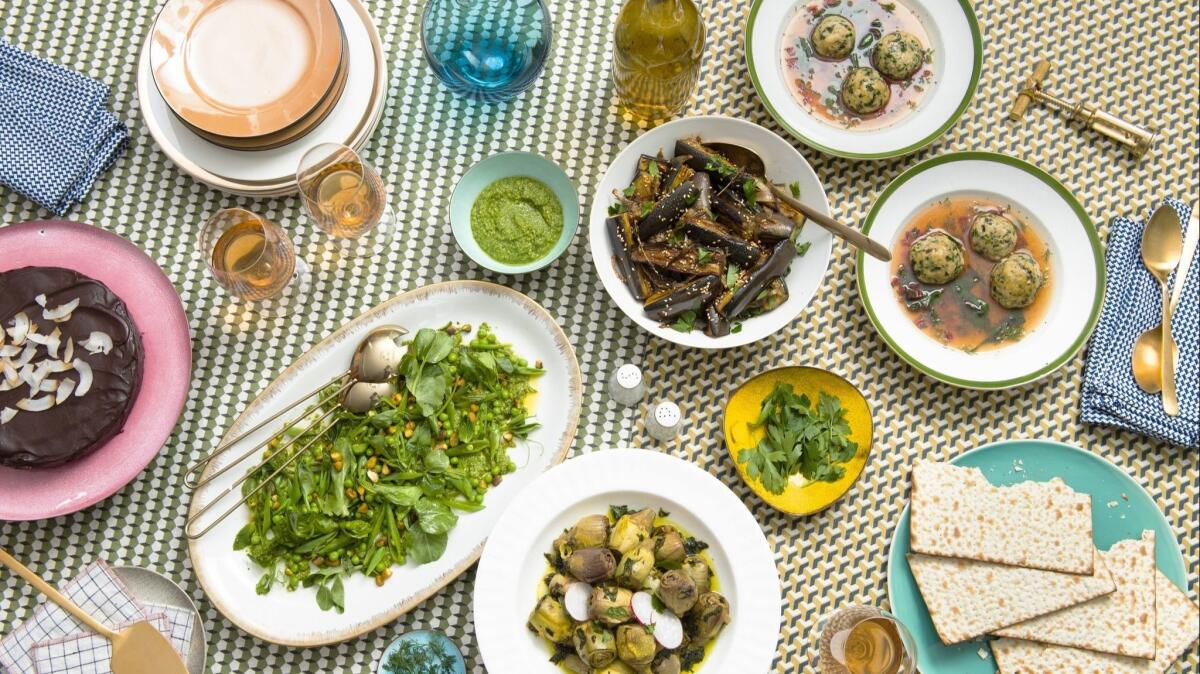
With a focus on renewal and regeneration, Passover is also known as the Holiday of Spring. Considered a kind of second Jewish new year, it’s only fitting that the table be filled with dishes that shine bright thanks to a garden’s worth of shoots, leaves, herbs and spices. Here, chefs from some of L.A’s Israeli-influenced restaurants share plant-driven Seder recipes that are beautiful, flavorful and easy to make in advance.
In the Passover Seders of my childhood, meal prep was as much a logistical feat as a culinary one. Before we sat down to a retelling of the Jews’ exodus from slavery in Egypt, my mother, Stephanie, would free herself from stress by preparing a series of smart sides that could be prepped almost entirely in advance, then finished with a few easy flourishes. You can do the same with these recipes, which would be delicious at any spring gathering.
Our menu comes from notable L.A. chefs and restaurants: Alex Chang at the Exchange starts the meal with a salad; Ori Menashe of Bavel and Or Amsalam and Alexander Phaneuf of Hasiba give us flavorful vegetable plates; Sarah Hymanson and Sara Kramer of Kismet wow with a matzoh ball soup for the main course (with a vegetarian option); and Momed’s signature flourless chocolate cake makes for an indulgent dessert.
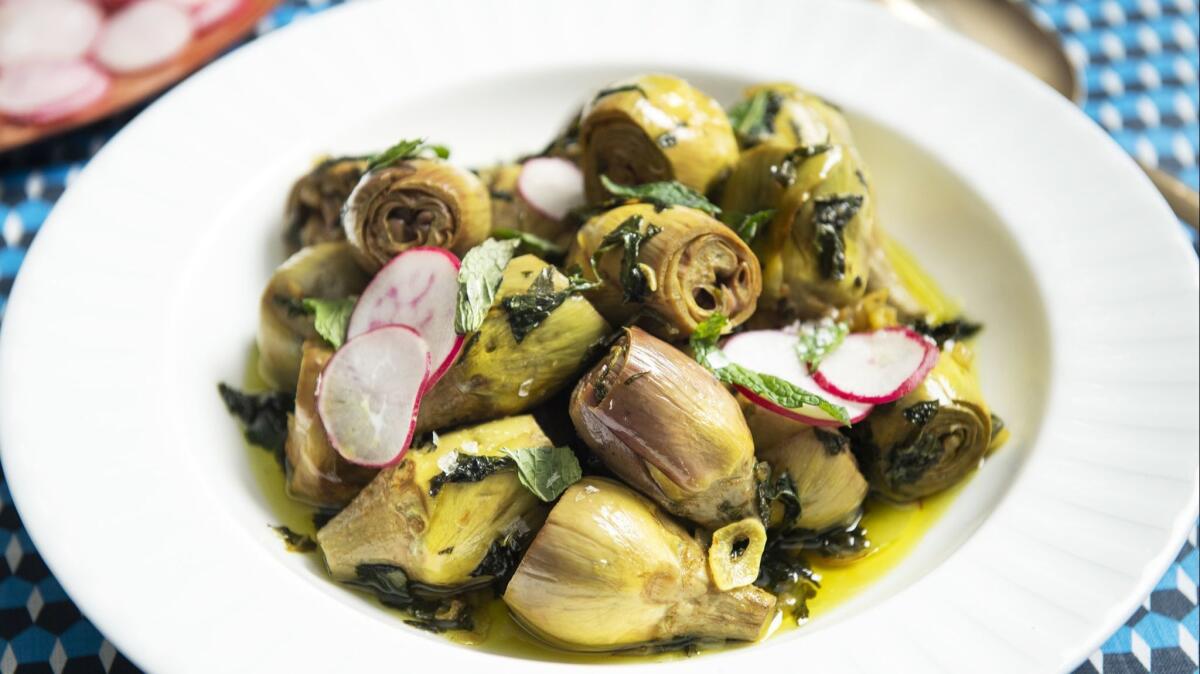
Bavel’s Herbed Confit Baby Artichokes
View recipe in our California Cookbook »
50 minutes plus cooling. Serves 8 to 10.
Ori Menashe of Bavel in the Arts District shares a technique for preserving whole baby artichokes in olive oil infused with a riot of spices.
2 large lemons
32 baby artichokes (3 ½ to 4 pounds)
2 ½ cups flat-leaf parsley leaves, chopped
1 cup cilantro, chopped
1 ¼ cups mint leaves, chopped
1 large onion, finely diced
3 large garlic cloves, very thinly sliced
1 ½ tablespoons ground cumin
1 tablespoon ground turmeric
1 tablespoon ground ginger
1 ½ tablespoons kosher salt
1 ¾ cups extra-virgin olive oil, plus more
4 small radishes, very thinly sliced
½ teaspoon dried marash pepper or red chile flakes
Maldon sea salt
1 Fill a large bowl with ice water and juice 1 lemon directly into the water. Pluck off any tougher outer leaves, then trim off the top ½ inch of the artichokes and trim the stems to ½ inch. Use a vegetable peeler to peel the tough outer layer where the leaves meet the stem, then drop the artichokes into the lemon water.
2 Combine the parsley, cilantro, 1 cup of the mint, the onion, garlic, cumin, turmeric and ginger in a 4-quart saucepan, stir to combine, and then spread in an even layer.
3 Drain the artichokes well, return them to the bowl and toss with the kosher salt and a splash of olive oil to evenly coat. Arrange the artichokes, stem sides up, in an even layer on top of the herb mixture in the saucepan. They should be wedged together. Pour in 1¾ cups olive oil, adding any additional if needed to completely cover artichokes. Bring to a boil over high heat and boil for 3 minutes. Reduce the heat to low, cover and simmer until tender, about 15 minutes.
4 Remove from the heat and let stand, covered, for 5 minutes. Uncover and cool to room temperature, at least 2 hours and up to 8 hours.
5 Using a slotted spoon, scoop out the artichokes and arrange on a serving platter. Drizzle some of the oil over the artichokes. Garnish with the radishes and remaining quarter cup mint, then squeeze juice from the remaining lemon over the artichokes. Sprinkle with the marash pepper and Maldon salt to taste.
Make Ahead: The cooked and cooled artichokes can be refrigerated in their oil in an airtight container for up to 5 days before garnishing and serving. After serving, the oil can be strained into an airtight container (discard the solids) and refrigerated for up to 1 month and used to dress salads.
Recipe from Ori Menashe, adapted by Adeena Sussman
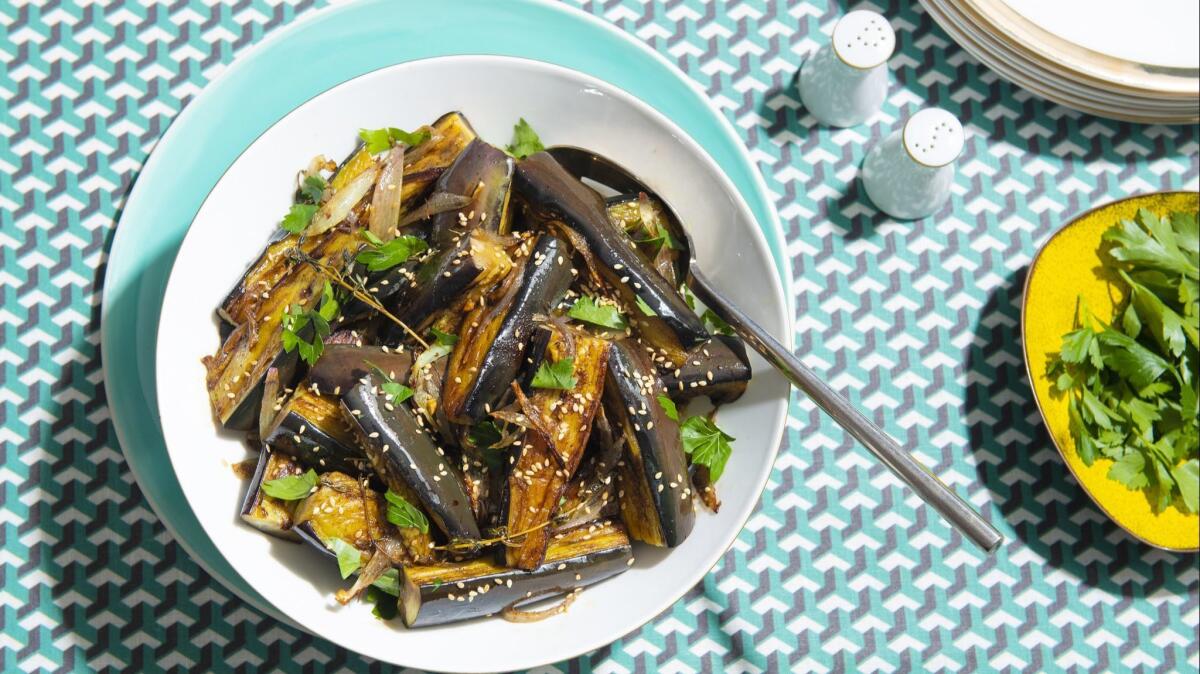
Hasiba’s Honeyed Marinated Eggplant
View recipe in our California Cookbook »
45 minutes plus draining and cooling. Serves 8 to 10.
Chefs Or Amsalam and Alexander Phaneuf of cult hummus joint Hasiba serve a must-order marinated eggplant that you can now make at home. Their recipe combines silky texture, puckery tartness and richness courtesy of olive oil in every bite.
2 large Italian eggplants (about 2 3/4 pounds)
Fine sea salt
1 1/2 cups extra-virgin olive oil, plus more
2 medium shallots, thinly sliced
2 medium garlic cloves, roughly chopped
1 ½ teaspoons sweet paprika
1/3 cup balsamic vinegar
1/3 cup sherry or red wine vinegar
3 thyme sprigs
2 tablespoons raw honey, plus more to taste
Juice of 1 large lemon
¼ cup flat-leaf parsley leaves, chopped
1 ½ teaspoons toasted sesame seeds
1 Trim 1 inch off the top and bottom of each eggplant. Halve each eggplant crosswise, then stand each half on one end and cut each into 8 wedges, for 32 pieces total. Toss the wedges with 1 tablespoon salt in a large bowl, then arrange them with one cut side down on a paper towel-lined baking sheet. Drain for 2 to 4 hours. Pat the eggplant dry with paper towels.
2 Heat a heavy-bottomed large skillet over medium-high heat. Add half cup olive oil, then arrange half the eggplant with one cut side down until the bottoms are golden brown, 5 to 6 minutes. Add an additional quarter cup oil, flip the eggplant and fry until the other side is golden brown, about 6 minutes more. Transfer to a plate to cool and repeat with the remaining eggplant and three-quarters cup olive oil.
3 Reduce the heat to medium-low and pour any oil left in the pan into a bowl. Return 2 tablespoons oil to the skillet, or add more fresh oil to make 2 tablespoons. Add the shallots and cook, stirring, until translucent, 2 to 3 minutes. Add the garlic and paprika and sprinkle with salt. Cook, stirring, until fragrant and caramelized, about 2 minutes. Add both vinegars, the thyme and 2 tablespoons water. Swirl the liquids and scrape any browned bits from the pan. Raise the heat to medium-high and cook until the liquid is reduced by half, 5 to 6 minutes.
4 Remove from the heat and stir in the honey. Add the eggplant and gently stir to coat. Reduce the heat to medium-low and cook until the eggplant softens but is not mushy, about 5 minutes. Cover and cook until the eggplant softens further and one-eighth inch of liquid remains in the skillet, about 5 minutes more. Taste and add more honey and salt, if desired.
5 Transfer to a nonreactive bowl and cool to room temperature, about 30 minutes. Cover with plastic wrap, transfer to the refrigerator and chill completely, at least 4 hours and up to 5 days.
6 When ready to serve, remove the eggplant from the refrigerator and let come to room temperature. Remove and discard the thyme sprigs. Stir in the lemon juice, then garnish with the parsley and sesame seeds.
Make Ahead: The eggplant can be refrigerated tightly covered for up to 5 days.
Recipe from Alexander Phaneuf, adapted by Adeena Sussman
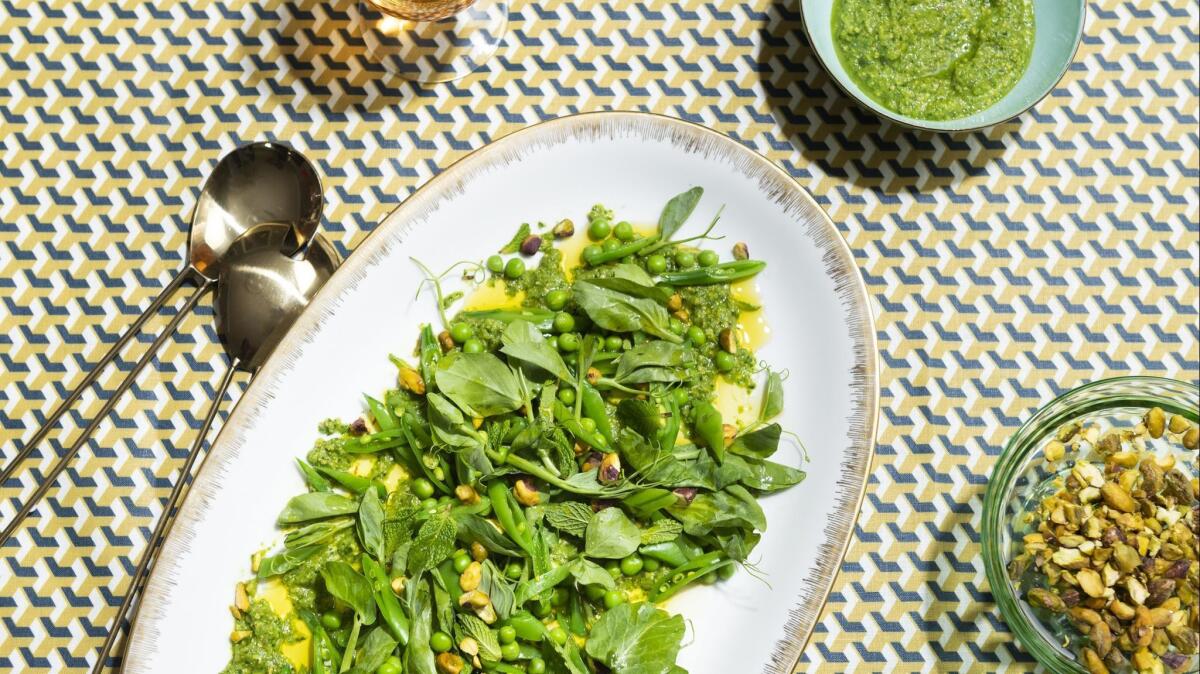
The Exchange’s Spring Pea Salad with Pistachio Pipian
View recipe in our California Cookbook »
45 minutes plus chilling. Serves 8 to 10
Alex Chang at the Exchange downtown contributes a festival salad with a tart tomatillo-based pipian sauce — traditionally made with pumpkin seeds — and blends in pistachios instead, which also add crunch as a topping.
Kosher salt
12 ounces sugar snap peas, tough strings removed
2 cups shelled fresh peas (12 ounces) or thawed frozen peas
2 cups pea shoots (1 ½ ounces)
¼ cup mint leaves
2 tablespoons fresh lime juice
2 tablespoons extra-virgin olive oil
Pistachio Pipian Dressing (recipe follows)
½ cup shelled roasted and salted pistachios, roughly chopped
1 Bring a large pot of salted water to a boil. Fill a large bowl with ice water. Submerge the snap peas and shelled peas in the boiling water. Return to a boil, then boil for 1 minute. Drain, then immediately transfer to the ice water. Let cool for 2 minutes, then drain again. Pat the peas dry with paper towels.
2 Thinly slice the snap peas at an angle and toss them in a large bowl with the shelled peas, pea shoots, mint, lime juice, olive oil and one-half teaspoon salt until evenly coated.
3 Spread the pipian dressing on a serving platter, mound the salad on top, and sprinkle with the pistachios.
Pistachio Pipian Dressing
3 tomatillos (about 6 ounces), husked and rinsed
3 small yellow onions, peeled and root ends trimmed but left whole
3 serrano chiles, stemmed
6 tarragon sprigs
¼ cup shelled roasted and salted pistachios
1 cup packed spinach leaves
1 teaspoon kosher salt
1 tablespoon fresh lime juice
1 Make the pipian: Place the tomatillos, onions, chiles, tarragon and pistachios in a medium saucepan and add enough cold water to cover by 1 inch. Bring to a boil, then reduce the heat to medium-low and simmer until the onions are tender but don’t yield completely when pierced with a fork, 25 to 30 minutes.
2 Reserve a quarter cup of the cooking water, then drain and transfer the solids to a blender. Add the spinach and salt and blend until smooth, adding cooking water by the tablespoon to loosen, if necessary. The sauce should be quite thick. Stir in the lime juice, then transfer to an airtight container and refrigerate until ready to serve.
Make Ahead: The pipian can be refrigerated in an airtight container for up to 1 day.
Recipe from Alex Chang, adapted by Adeena Sussman
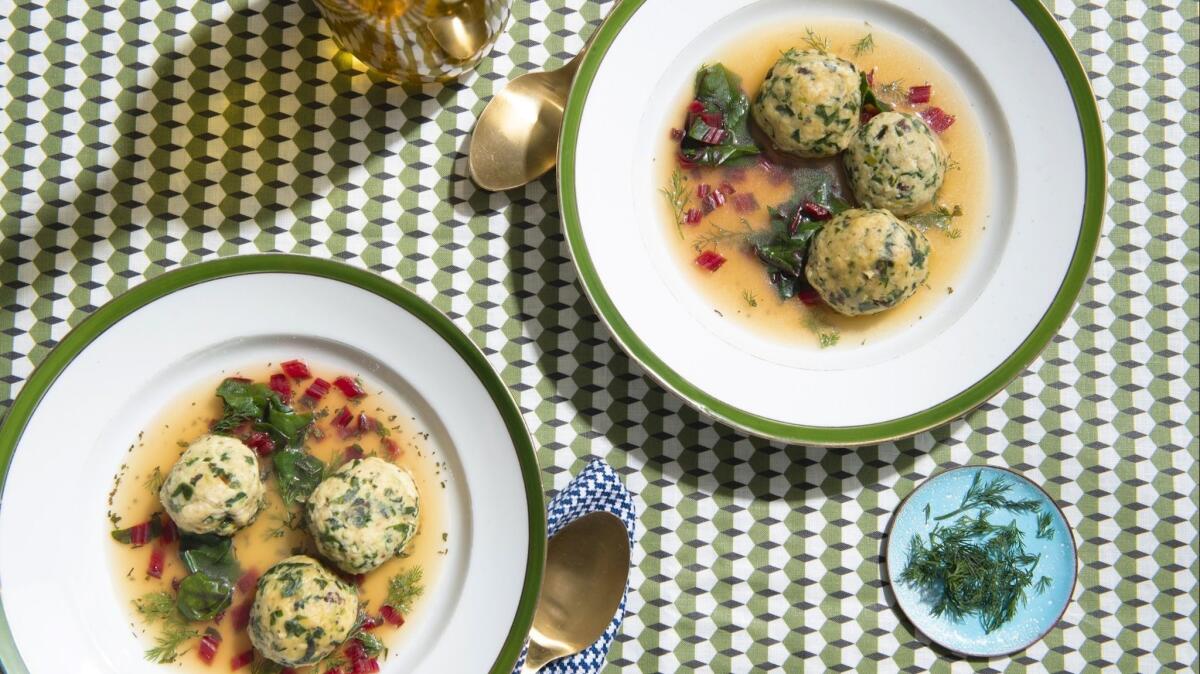
Kismet’s Chard and Leek Matzo Ball Soup
View recipe in our California Cookbook »
2 hours plus chilling. Serves 8 to 10
Chefs Sarah Hymanson and Sara Kramer of Kismet in East Hollywood share their take on matzo ball soup, shot through with a deep tartness courtesy of roasted lemons. We simplified their original stuffed matzo balls by stirring the flavorful chard mixture right into the batter. If you’re feeling ambitious, you can do as the pros do: Roll the matzo balls and cook the chard mixture, chill them separately, then poke a teaspoon of filling inside each ball before reclosing and cooking. You can make this vegetarian by substituting olive oil for the chicken schmaltz and vegetable stock for the chicken stock.
1 medium leek
1 large bunch Swiss chard (1 ¼ pounds)
8 tablespoons schmaltz (rendered chicken fat) or extra-virgin olive oil
1 garlic clove, minced
¼ teaspoon ground allspice
Kosher salt
3 tablespoons currants
2 tablespoons pine nuts, toasted and coarsely chopped
1 teaspoon finely grated lemon zest
4 large eggs
1 cup matzo meal
½ teaspoon baking powder
4 quarts, plus 1/3 cup unsalted chicken or vegetable stock
3 lemons, scrubbed
4 shallots, halved
2 fresh or dried bay leaves
1 cinnamon stick
1 teaspoon dried mint
1/2 cup fresh dill fronds
1 Separate the leek greens from the whites, and finely chop the leek whites; reserve the leek greens. Separate the chard leaves from the stems, then cut the stems and 1 cup leaves into thin slices. Reserve the sliced chard stems and leaves for the broth and reserve the remaining chard leaves for the matzo balls.
2 Make the matzo ball dough: Heat 2 tablespoons schmaltz in a large skillet over low heat. Once the fat begins to shimmer, add the leek whites, garlic, allspice and a half teaspoon salt. Cook, stirring often, until translucent, about 5 minutes.
3 Add the reserved chard leaves and cook, stirring often, until the leaves are soft and all the liquid has evaporated, about 5 minutes. Transfer the mixture to a cutting board, cool for 5 minutes, and finely chop. Transfer to a medium bowl and stir in the currants, pine nuts and lemon zest.
4 Whisk the eggs in a large bowl until frothy, then slowly whisk in the remaining 6 tablespoons schmaltz, followed by the matzo meal, baking powder and 1 ½ teaspoons salt. Stir in one-third cup chicken stock just until combined. Gently fold in the cooked chard mixture until evenly distributed. Cover and refrigerate for at least 1 hour or up to 8 hours.
5 Meanwhile, make the broth: Heat the oven to 400 degrees. Put the lemons on a small baking sheet and roast until caramelized with dark spots, 35 to 40 minutes.
6 While the lemons roast, combine the shallots, bay leaves, cinnamon stick, remaining 4 quarts stock and reserved leek greens in a large, wide saucepot or Dutch oven and bring to a simmer over high heat. Cut the roasted lemons in half and squeeze their juice into the broth, then add the rinds to the pan. Simmer for 30 minutes.
7 Strain the broth through a fine-mesh sieve, discarding the solids, and return to the saucepot. Stir in the mint and 2 teaspoons salt. Taste and add more salt if desired. Bring to a simmer.
8 Use slightly wet hands to form the chilled matzo ball mixture into 20 equal-size balls. Drop them into the simmering broth. Once they float, cover and simmer until the balls puff up, 35 to 40 minutes. Stir in the reserved sliced chard stems and leaves and simmer until tender, about 5 minutes more.
9 To serve, ladle the soup and matzo balls into bowls and garnish with the dill.
Make Ahead: The chard mixture and broth can be refrigerated in airtight containers for up to 1 day. The matzo ball mixture can be covered and refrigerated for up to 8 hours.
Recipe from Sarah Hymanson and Sara Kramer, adapted by Adeena Sussman
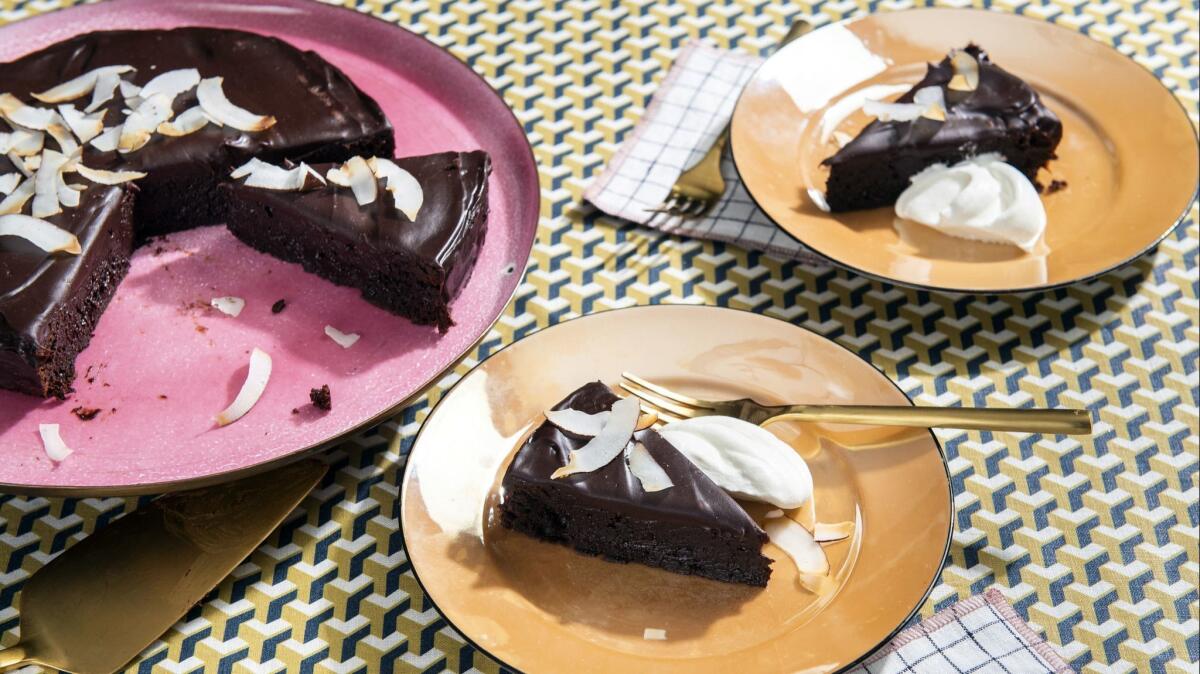
Momed’s Flourless Chocolate Cake
View recipe in our California Cookbook »
35 minutes plus cooling and chilling. Serves 8 to 10
I replaced the heavy cream and butter in Momed’s signature flourless chocolate cake with coconut cream and coconut oil in case you’re serving your favorite brisket recipe at Passover and are avoiding dairy for kosher reasons — but the cake’s fudgy texture and toasty taste is all the better for it.
For an additional flourish, you can serve slices with whipped coconut cream. To make it, refrigerate a can of full-fat coconut milk until very cold. Open the can and spoon only the solid parts into a chilled bowl (don’t get any liquid in there). Whisk until soft peaks form.
1/2 cup unrefined coconut oil, plus more for greasing the pan
2 1/2 cups semisweet chocolate chips
3/4 cup granulated sugar
1 teaspoon pure vanilla extract
1/4 teaspoon fine sea salt
3 large eggs, lightly beaten
1/2 cup unsweetened cocoa powder, sifted
1/2 cup full-fat coconut milk
1/4 cup unsweetened coconut flakes, toasted
1 Make the cake: Heat oven to 350 degrees. Grease an 8-inch round springform pan with coconut oil. Line the bottom with parchment paper and grease the parchment.
2 Melt the coconut oil and 1 1/2 cups chocolate chips together, either by stirring in a saucepan over low heat until smooth or microwaving in a large microwave-safe bowl in 30-second increments, stirring between each until smooth, about 1 ½ minutes.
3 Whisk in the sugar, vanilla and salt until incorporated, then whisk in the eggs until smooth. Whisk in the cocoa powder until just combined. Pour the batter into the prepared pan and smooth the top with a spatula. Bake until the cake forms a thin crust on top and the center is still slightly jiggly, 20 to 25 minutes.
4 Cool the cake on a wire rack for 10 minutes. If the edges seem stuck, loosen with an offset spatula or dull knife. Release the sides of the pan and remove. Cool completely on the base on a wire rack.
5 While the cake cools, make the ganache: Melt the remaining 1 cup chocolate chips and the coconut milk together either by stirring in a saucepan over low heat until smooth or microwaving in a large microwave-safe bowl in 30 second increments, stirring between each until smooth, about 1 minute.
6 Slide the cooled cake off the parchment on the base and directly onto the rack. Set the rack over a rimmed baking sheet. Pour the warm ganache over the center of the cake. Using a spatula, gently spread it out to the edges, letting it drip evenly down the sides. Smooth the sides and decoratively swirl the top, if desired. Refrigerate the cake, uncovered, until the ganache sets, 1 ½ to 2 hours. Sprinkle the toasted coconut flakes on top before serving.
Make ahead: The chilled frosted cake can be loosely covered with plastic wrap and refrigerated for up to 2 days.
Recipe from Momed, adapted by Adeena Sussman
More to Read
Eat your way across L.A.
Get our weekly Tasting Notes newsletter for reviews, news and more.
You may occasionally receive promotional content from the Los Angeles Times.









